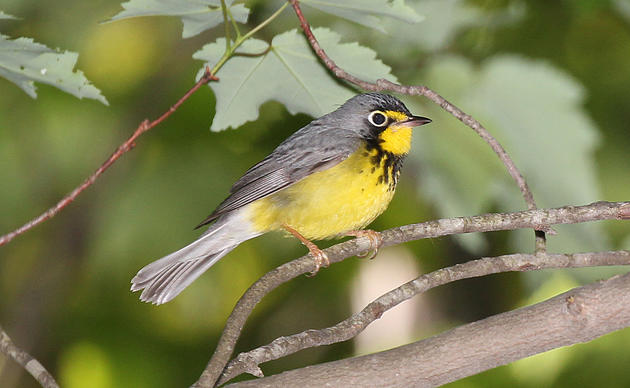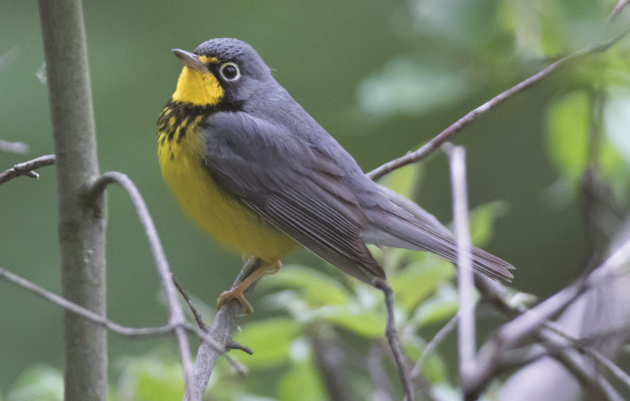Audubon Forester Training and Endorsement Program
Habitat for birds and other wildlife remains one of the primary management objectives for New York and Connecticut forest landowners.
Audubon is excited to assist foresters in meeting these land management objectives through our Audubon Forester Training and Endorsement Program. We welcome consulting, agency, industry, and procurement foresters in New York and Connecticut to participate in the program. (The program is also active in Vermont and Pennsylvania; click on your state for more information!)
The content of this training can be applied to private and public land and is compatible with many objectives, including timber production, water quality, recreation, and carbon sequestration.
The purpose of Audubon’s forester endorsement program is to create a national network of professional foresters working, in partnership with the National Audubon Society, to promote healthy forest ecosystems that provide high-quality habitat for priority bird species, at scale.
An Audubon endorsement means that participating foresters have completed our bird-friendly forestry training curriculum and demonstrated that they can apply the concepts we have taught them. Once endorsed, you will have access to our wide landowner base, and Audubon will promote and support your ongoing habitat work.
OVERVIEW: FROM TRAINING TO ENDORSEMENT
To receive an Audubon endorsement, foresters must complete the following steps:
- Complete the training webinar series, or an equivalent in-person Audubon training,
- Write an example silvicultural prescription that integrates bird habitat management based on a stand scenario we provide, and
- Provide two examples of new or revised management plans, updates, or amendments that integrate bird habitat management. For large management plans (e.g. public lands, industrial forests, etc.), foresters can revise two stand prescriptions rather than the entire plan.
STEP 1: COMPLETE THE TRAINING WEBINARS TO RECEIVE SAF CFE & CT CEU CREDITS
The program begins with a series of weekly training webinars, in which foresters will learn about birds in decline, landscape and stand-level planning and management to improve forest habitat diversity, resources available to assist foresters, and details about the Audubon Forester Endorsement Program.
After completing the webinar series, foresters can choose to continue with the next steps in the endorsement process. By completing these four sessions, foresters are eligible to receive 4 SAF CFE credits and/or 4 CT CEUs before moving on to the endorsement process.
Training sessions can be accessed at any time and streamed at a time conducive to your schedule. However, we ask that you watch all four sessions before advancing to the next steps of the endorsement process.
SAF CFEs have been approved for recorded webinars (1 Cat 1 CFE per webinar). Each webinar is also approved for 1 CEU for CT Certified Forest Practitioners. To receive CFEs or CT CEUs for viewing a recorded webinar, as well as credit towards endorsement, foresters will need to submit answers to two questions for each webinar.
How to submit answers: Please submit your answers by either uploading them via the links below, or by emailing them to an Audubon Connecticut & New York staff member via the information listed at the bottom of this page. Include the subject “Training Webinar Questions” along with your SAF or state license identification and we will make sure you receive the necessary credits. We suggest you familiarize yourself with these questions before watching so that you’re prepared to provide answers.
Webinar #1: Forester Training and Endorsement Program and Introduction to the Healthy Forest Initiative
- Watch the recording here
- Upload answers here if you are based in CT, or here if based in NY, or email Audubon staff in your state (contact info below)
- Name the four bird species that were discussed during the presentation
- List three threats/stressors to forest habitat quality
Webinar #2: Forest Bird Habitat Management Planning and Assessments
- Watch the recording here
- Upload answers here if you are based in CT, or here if based in NY, or email Audubon staff in your state (contact info below)
- To meet the full breeding cycle (nesting and post fledging phases) needs of forest birds, what percentages of a mostly forested landscape should be in young and mature forest age classes?
- Name three stand-level habitat conditions that can be created or improved through forest management.
Webinar #3: Forest Management for Birds
- Watch the recording here
- Upload answers here if you are based in CT, or here if based in NY, or email Audubon staff in your state (contact info below)
- To enhance vertical structural diversity within a mature forest using small group selection, what is the approximate size range of groups in acres?
- How many years after a clearcut (2-5+ acres in size) will forest birds start appearing?
Webinar #4: Resources for Foresters, Engaging Landowners and Current Audubon Projects
- Watch the recording here
- Upload answers here if you are based in CT, or here if based in NY, or email Audubon staff in your state (contact info below)
- When writing an integrated forest and bird habitat management plan, habitat should be assessed at two different scales or levels and addressed in prescriptions. What are those two scales or levels?
- Please list one location where Audubon has a forest habitat demonstration site.
MOVING PAST TRAINING INTO THE ENDORSEMENT PROCESS
Now that you’ve completed the four endorsement-training sessions you might be asking yourself, what’s next?
You are not obligated to continue past the training into the endorsement process to receive CFE/CEU credits. However, should you become endorsed, Audubon will provide access to our wide landowner base while promoting and supporting your ongoing habitat work. We also will remain available to you as a resource when incorporating bird habitat considerations into your forest management planning.
STEP 2: WRITE AN EXAMPLE SILVICULTURAL PRESCRIPTION
Given mock landowner objectives, landscape descriptions, parcel and stand data, respond to questions and develop stand-level prescriptions that incorporate some of the bird-friendly forestry concepts we outlined in the training. Please choose one scenario from the options below and upload your stand prescription here if you are in CT, or here if you are in NY.
STEP 3: PROVIDE EXAMPLES THAT INTEGRATE BIRD HABITAT MANAGEMENT
Develop two forest management plans (either brand new plans or new activity schedule updates) that incorporate these concepts OR take a previously written plan and apply these bird-friendly concepts where suitable within the calendar year. For large management plans (e.g. public lands, industrial forests, etc.), foresters can revise two stand prescriptions rather than the entire plan. Upload new or updated management plans here if you are in Connecticut or if you are in New York.
For each plan submitted, include a completed cover sheet to indicate which bird-friendly management concepts are incorporated. Download the cover sheet here.
Additional resources for writing prescriptions and management plans:
Audubon New York Forester’s Guide
Audubon Connecticut Forest Management Guide
Need more examples? The following plans were developed and/or amended to create or improve forest bird habitat while meeting additional landowner objectives. Examples range from NY 480a harvest plans, NRCS conservation activity plans, Use Value Appraisal plans, and general forest management plans.
The first two plans with stars next to them are great examples of bird-friendly forest management plans. We encourage you to apply the same landscape and stand-level considerations to your stand scenario prescription in Step 2 and new or revised management plans or stand prescriptions in Step 3.
- ** CAP106 Managing Your Woodlands Management Plan
- ** Vermont Land Trust's "Mud Pond Demonstration Forest" Management Plan
- Section 480-A Real Propety Tax Law Forest Management Plan
- CAP106 Managing Your Woodlands Management Plan (with addendum)
- Early Successional Forest Management Plan (Rheinstrom Hill Audubon Center and Sanctuary)
- Use Value Appraisal Plan
- Vermont Example Plan
Please note that some of the management plan examples were written with forest birds in mind but might not directly address landscape or stand-level habitat considerations. However, we learned these plans were written with birds in mind from the foresters that wrote them. As discussed in Webinar #4, we understand that every plan or prescription you develop may not directly address bird habitat (e.g. 480a plan), but that you did consider and propose management that will indeed improve forest age class diversity and within stand structure and complexity. Once you are endorsed by Audubon, we encourage you to still include those plans that may not directly address forest bird habitat in your annual reporting.
MAINTAINING ENDORSEMENT
Foresters will be asked to share baseline information annually, and to participate in at least two continuing education programs every other year.
ANNUALLY
Share information with Audubon so we can assess our cumulative impact on forest bird conservation. We’ll be asking about things like the number of bird-friendly forest management plans you’ve written, the number of acres included in those management plans, and the number of acres that received management that benefits birds. We may reach out for this information in late May or early June. We hope to have an easy-to-use online form for information sharing.
EVERY OTHER YEAR
Participate in at least two continuing education opportunities provided by Audubon or other agencies and organizations. These programs will also be preapproved for SAF credits (and state CEUs where applicable) and participation certificates will be provided. Audubon will notify endorsed foresters of the continuing education programs in advance and welcome your suggestions for topics we cover and field sites we visit for in-person programming.
Additional resources that may help when developing your plans can be found here:
Audubon New York's Forest Resource Center
Audubon Connecticut's programs and resources

AUDUBON STAFF CONTACT INFORMATION
- New York: Claire Mann, Forest Program Senior Associate, Audubon New York
- Email: claire.mann@audubon.org
- Phone: (585) 447-0961
- Connecticut: Rosa Goldman, Forest Program Senior Associate, Audubon Connecticut & New York
For Audubon Forester Training and Endorsement in other states, please visit their respective program websites:
Vermont
Pennsylvania

Audubon's Forester Training and Endorsement Program is funded by a Landscape Scale Restoration grant by the U.S Department of Agriculture, Forest Service, an equal opportunity provider, National Fish and Wildlife Foundation New England Forests and Rivers Fund, Davis Conservation Foundation, LuEsther T. Mertz Charitable Trust, Overhills Foundation and Daybreak Fund (Vermont Community Foundation).
Additional program support & partners:
- New York and Green Mountain Division - Society of American Foresters
- NYS Department of Environmental Conservation
- Woods, Wildlife, and Warblers
- VT Woodlands Association
- Forest Stewards Guild
Related
Audubon Announces First-Ever Endorsed Foresters
We are thrilled to share that Caitlin Cusack (Vermont) and John MacNaught (New York) have become endorsed for prioritizing bird habitat in their management recommendations.
Managing Forests for Birds: a Forester's Guide
This guide serves as a resource for foresters and other land managers to integrate habitat components into forest management planning.
How you can help, right now
Donate to Audubon
Help secure the future for birds at risk from climate change, habitat loss and other threats. Your support will power our science, education, advocacy and on-the-ground conservation efforts.






